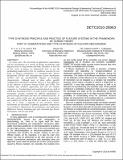Type Synthesis Principle and Practice of Flexure Systems in the Framework of Screw Theory: Part III—Numerations and Synthesis of Flexure Mechanisms
Author(s)
Li, S. Z.; Yu, J. J.; Pei, X.; Su, Hai-jun; Hopkins, Jonathan B; Culpepper, Martin; ... Show more Show less
Download619_1.pdf (750.1Kb)
PUBLISHER_POLICY
Publisher Policy
Article is made available in accordance with the publisher's policy and may be subject to US copyright law. Please refer to the publisher's site for terms of use.
Terms of use
Metadata
Show full item recordAbstract
In recent years, the increasing of application requirements call for development of a variety of flexure mechanisms with high precision or large motion and both. Therefore, in Part III of this series of papers we demonstrate how to use the methodology addressed in Part I to synthesize concepts for two kinds of flexure mechanisms, i.e. kinematics-type flexure mechanisms (KFMs) and constraint-type flexure mechanisms (CFMs) with the specified-DOF (Degree of Freedom) characteristics. Although most of them utilize parallel configurations and flexure elements, there is a clear difference in the behavior of flexures between KFMs and CFMs, The resultant type synthesis approaches fall into two distinct categories i.e. freedom-based and constraint-based one, both of which have presented in Part I. In order to derive useful flexure mechanism concepts available for different applications, a general design philosophy and rules are summarized firstly. As the main content of this part, the classifications, numerations, and synthesis for KFMs and CFMs are made in a systematic way. As a result, a majority of new precision flexure mechanisms are developed. In addition, qualitative comparisons are provided to demonstrate the performance and application differences between kinematic-type and constraint-type flexure mechanisms with the same DOF.
Date issued
2010-08Department
Massachusetts Institute of Technology. Department of Mechanical EngineeringJournal
Volume 2: 34th Annual Mechanisms and Robotics Conference, Parts A and B
Publisher
ASME International
Citation
Li, S. Z., J. J. Yu, X. Pei, Hai-jun Su, J. B. Hopkins, and M. L. Culpepper. “Type Synthesis Principle and Practice of Flexure Systems in the Framework of Screw Theory: Part III—Numerations and Synthesis of Flexure Mechanisms.” Volume 2: 34th Annual Mechanisms and Robotics Conference, Parts A and B (2010), Montreal, Quebec, Canada, ASME International, 2010. © 2010 ACME International
Version: Final published version
ISBN
978-0-7918-4410-6